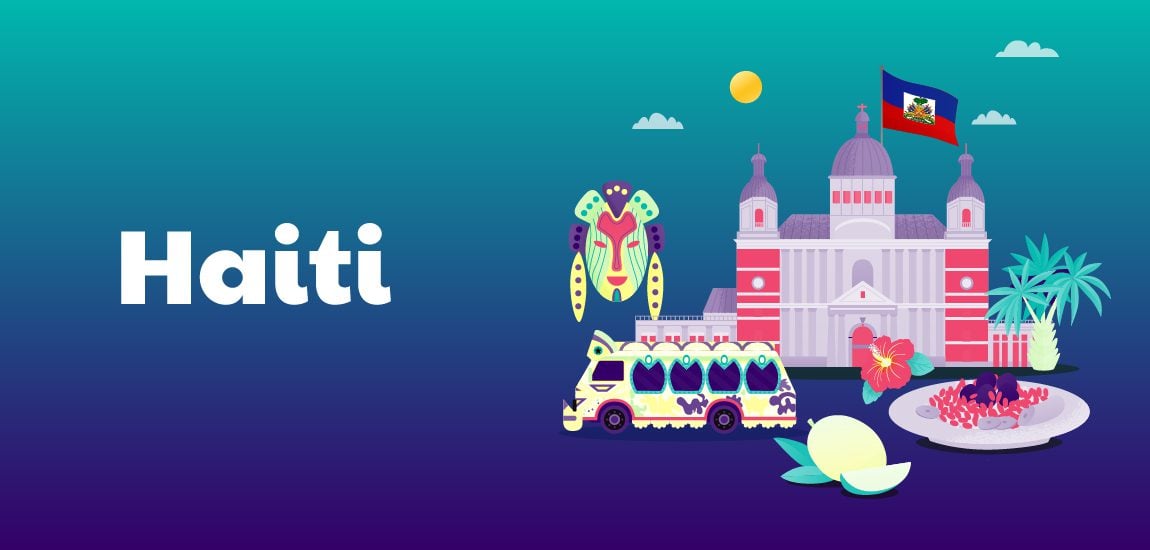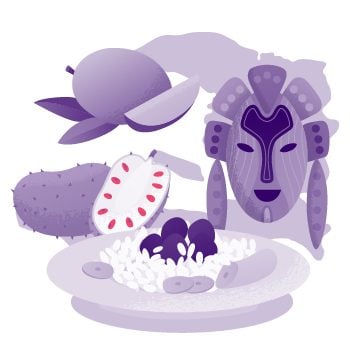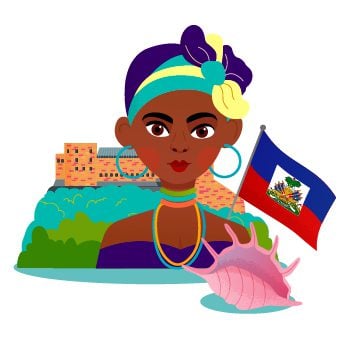
What Language Do Haitians Speak?
The official language of Haiti is French.
Haiti is a small Caribbean island with a long and complex history of French, African, and Latin American influences. As such, the national language of Haiti is French. This dates back to the 17th and 18th centuries when French settlers from Santo Domingo colonized the area. French speakers were the minority, but they significantly influenced Haitian culture, particularly regarding language. It is derived from French and has been influenced by other languages, such as Spanish and Portuguese. While English is spoken in some parts of the country, particularly in tourist areas, Haitian Creole remains the common home language for most Haitians. Various resources, such as Creole Language Libraries, exist to help people learn and understand Haitian Creole. However, Haiti still has an educational language policy problem since French remains the primary language used in schools. This limits students’ ability to learn Haitian Creole and understand their culture through advocacy. Though derived from French, Haitian Creole has its unique grammatical structure. A basic verb form is shared among all varieties of Creole, while the conjugation of common verbs differs from that of French. As such, learning Haitian Creole is challenging for those used to French.


However, the majority of Haitians speak Haitian Creole.
Haitian Creole is a foreign language spoken primarily by people of Haitian descent, and it has its roots in the 17th and 18th centuries when French was the official language of Haiti. Haitian Creole is also spoken in other parts of the Caribbean, such as Santo Domingo, and is used as a standard home language among Latin American and African slaves. It is still considered a minority language, but more French speakers are becoming familiar with it.A Creole Language Library seeks to promote Haitian culture through advocacy and preservation. The library provides resources on the basics of Haitian Creole, such as common verb forms and how to construct sentences, which are essential for learning the language.
Furthermore, there is an educational language policy problem because schools in Haiti often only teach students in French. This makes it difficult for many students to learn Haitian Creole, as it is not their primary language. Despite this, most Haitians still speak Haitian Creole, which remains part of the national language. It is the most commonly spoken language in Haiti and serves as a common form of communication between Haitians and those who may not be familiar with French. It is also a way to celebrate the unique culture of Haiti and keep the language alive.
However, the majority of Haitians speak Haitian Creole, reflecting its wide range of influences from the 20th century and the historical context of the slave population. This contributes to its unique vocabulary and grammar, including expressions like “bekàn mwen.” Learning resources like an audio phrasebook can aid in mastering pronunciation, including the correct enunciation of silent letters, further improving literacy rates among Haitian populations.
Learning Haitian Creole
One difficulty for speakers learning the Haitian Creole language is mastering the unique features such as nasal vowels, rounded vowels, nasal sounds, and nasal consonants, distinct from the basic verb forms and oral consonants found in other languages like French. The presence of stative verbs, verb markers, and definite articles, combined with specific nuances like article nasalization, presents a challenge, especially for those familiar with the linguistic structures of the 20th century. For example, the lexical variation in phrases like “machin mwen” may be difficult for speakers accustomed to the more straightforward structures in languages like French or English. Educa Vision’s audio phrase book and resources like Lexington Books aim to assist learners in overcoming these challenges and understanding the linguistic diversity of Coconut Creek, catering to both black and white individuals in their language-learning journey.
Learning Haitian Creole can be a fascinating journey, especially for Haitian people and populations interested in mastering the unique features of the language, such as nasal vowels, rounded vowels, and stative verbs, influenced by French articles and a broad range of linguistic influences from the 19th century. With its rich history and diverse vocabulary, mastering Haitian Creole involves understanding its form of action verbs, verb markers, and silent letters, which is essential for improving literacy rates and communication skills among black people in regions like Coconut Creek. Additionally, resources like an audio phrasebook can aid in mastering pronunciation and oral vowels in this vibrant language.
In learning Haitian Creole, individuals encounter linguistic challenges such as base variation and allomorphic variation, which can be distinct from the linguistic structures in languages like French. These variations apply to various elements, including action verbs, creating a unique linguistic landscape for black people and white individuals seeking proficiency in Haitian Creole.
Haitian Creole is derived from French but also has influences from other languages.
Haitian Creole is the primary language of Haiti, and its official language is French. Haitian Creole, or Kreyòl, originates in the 17th century when French colonists brought enslaved Africans to the island, and it has since developed into its distinct language. Haitian Creole combines French, African languages, and Caribbean dialects. The French language was the primary language used by the colonial rulers on the island and remains an integral part of the national language. Haitian Creole is spoken by most Haitians and used in daily conversations. There are also foreign words in the language, like Spanish and Taino, which migrants from Latin America and the Caribbean brought. The influence of French can be seen in Haitian Creole’s vocabulary, pronunciation, and grammar. French articles are often incorporated into sentences, and a common verb form is used in many other French-speaking countries.
There is also a Creole Language Library in Santo Domingo, where books and other resources help people learn Haitian Creole. In addition to French, Haiti’s culture and traditions have significantly influenced Haitian Creole. The culture has been shared through stories, songs, proverbs, and everyday conversations. The government has also made Haitian Creole a priority language, recognizing it as a minority language and allowing it to be taught in schools. As a result, more people speak Haitian Creole as their shared home language. Despite this progress, Haiti still has an educational language policy problem. Many Haitians still face discrimination for using Haitian Creole as their primary language, and there is a lack of resources to help students learn it as a basic verb form. It is hoped that by advocating for culture through advocacy, more Haitians will be able to enjoy their native language without facing stigma or discrimination.
Get more information about what language is spoken in Guyana.

Haitians are bilingual and can speak both French and Haitian Creole.
Haitian Creole is the national language of Haiti and has been spoken by most Haitians since the 17th century. It is a Creole language derived from French but influenced by other languages. This is due to several reasons, including the history of the country’s culture and language. When African slaves were brought to Haiti in the 18th century, they were forced to learn French to communicate with their slave masters. Over time, these slaves created a pidgin form of French that eventually evolved into Haitian Creole. In addition, when the French took over the neighboring island of Santo Domingo in 1795, many French speakers migrated to Haiti and contributed to the development of Haitian Creole. Today, Haitian Creole is recognized as a foreign language with its grammar, vocabulary, and writing system. However, some challenges are still associated with its usage as an educational language in Haiti.
A problem exists concerning its official recognition as the national language and its implementation as part of the educational language policy. Many Haitians cannot access written material in Haitian Creole, and most of the content available at the Creole Language Library is written in French. Despite this, many Haitians continue to use Haitian Creole as their shared home language and sometimes even speak it among family members who may not be native speakers. As a result, many Haitians have a good grasp of primary verb forms and common verbs in both French and Haitian Creole. Furthermore, efforts are being made to increase the visibility of Haitian Creole in the international community and promote its use as a way of preserving Haitian culture through advocacy.
English is also spoken by some Haitians, particularly in tourist areas.
While French is Haiti’s official language and most Haitians speak Haitian Creole, English is still spoken by some people in the country. It is estimated that approximately 15-20% of Haitians can speak some form of English, particularly in tourist areas. This is due to various factors, including that Haiti borders the Dominican Republic, where Spanish is spoken. The history of English in Haiti is rooted in the 17th century when foreign-language speakers from Europe, Africa, and Latin America were brought to the island as slaves. The language that these slaves spoke came to be known as Haitian Creole, and over time it became the primary language of Haiti. In the 18th century, when France re-colonized Haiti, French became the official language.
However, the presence of the French speakers was not enough to completely displace Haitian Creole. As a result, both languages remained, with Haitian Creole continuing to be spoken by most Haitians. Today, several initiatives are in place to help promote and preserve Haitian culture through advocacy for Haitian Creole. For example, a Creole Language Library has been established to support research into the language and to make it more accessible to people outside of Haiti. Additionally, a standard home language policy has been implemented, which promotes the use of Haitian Creole as the language of instruction in schools. English is still a minority language in Haiti, but it is often used as a second language in many educational contexts and for communication with tourists and other foreign visitors. Though English does not have a strong presence in daily life, it offers Haitians access to more significant opportunities and resources. It provides a gateway to understanding other foreign languages and cultures.

North Carolina’s Multicultural Legacy
In the 17th century, North Carolina emerged as a cultural crossroads, a trend that persists today. Among its diverse population are 2,838 Haitian Creole-speaking English-language learners, highlighting the state’s dynamic multicultural fabric. Within this milieu, encounters range from a non-black Haitian man navigating linguistic nuances to a mambu Vodou priestess bridging spiritual traditions. Understanding Haitian Creole transcends mere language proficiency; it fosters connections and unity amidst linguistic diversity. Every conversation becomes an opportunity to bridge gaps and celebrate differences. With a keen note of language distinctions, North Carolinians navigate cultural landscapes with respect and appreciation, enriching their communities with every interaction.
Native speakers of Haitian Creole are found not only in Haiti but also across Latin America, where the language serves as a common home language for many communities. Within this diverse linguistic landscape, Haitian Creole exhibits a wide range of dialects and variations, reflecting its adaptability and resilience. From the bustling streets of Port-au-Prince to the vibrant neighborhoods of Latin American cities, the melodic tones of Haitian Creole unite people in shared experiences and traditions. As a common home language, it bridges cultural divides and fosters connections, empowering individuals to express themselves authentically and with pride. Through the voices of native speakers, Haitian Creole continues to evolve and thrive, embodying the rich heritage and spirit of its people.
Haitian Creole’s Linguistic Journey
In the ever-evolving landscape of language, Haitian Creole stands out for its wide range of verb markers and forms of action verbs. These linguistic features, honed over centuries of cultural exchange, reflect the dynamic nature of communication in the 20th century and beyond. From the bustling markets of Haiti to diaspora communities worldwide, the melodic rhythms of Haitian Creole find expression in everyday interactions. To aid learners and enthusiasts alike, resources like audio phrase books offer invaluable insight into the nuances of pronunciation and usage, ensuring that the vibrant spirit of Haitian Creole remains accessible to all. As language continues to shape our understanding of the world, the rich tapestry of Haitian Creole serves as a testament to the power of communication to bridge divides and foster connection.
The evolution of Haitian Creole is a testament to its broad range of influences, spanning centuries of cultural exchange and historical context. From the diverse linguistic traditions of Africa to the colonial legacy of European powers, the language reflects a rich tapestry of cultural borrowings and adaptations. Amidst this complex interplay of influences, the voices of the enslaved African population played a significant role in shaping the linguistic landscape, infusing Haitian Creole with their unique experiences and expressions. Nasal consonants, a distinctive feature of the language, add a melodic quality to speech, further enhancing its rich and expressive character. In every syllable and intonation, Haitian Creole encapsulates the resilience and creativity of its speakers, serving as a powerful symbol of identity and heritage.
Educational Resources: Haitian Creole Mastery
Through educational resources like Educa Vision and publications from Lexington Books, learners have the opportunity to delve deep into the intricacies of Haitian Creole. With a focus on oral vowels, consonants, and the nuances of pronunciation, these materials empower individuals to engage with the language with confidence and proficiency. Whether exploring the rich cultural heritage embedded in oral traditions or honing language skills through structured learning, Educa Vision and Lexington Books offer a comprehensive approach to language acquisition. By fostering an environment of exploration and understanding, they equip learners with the tools they need to navigate the complexities of Haitian Creole with ease. With each lesson learned and each concept mastered, learners emerge with a newfound appreciation for the beauty and depth of this vibrant language.
In the 17th century, North Carolina began its legacy as a melting pot of cultures, a tradition upheld by its diverse population today. Among them are 2,838 Haitian Creole-speaking English-language learners, showcasing the state’s vibrant multiculturalism. From a non-black Haitian man to a mambu Vodou priestess, understanding Haitian Creole serves as a bridge across communities, emphasizing the importance of language in forging connections.Meanwhile, in Coconut Creek, French-based Creole thrives as a common home language, enriching daily interactions with phrases like “machin mwen” and the subtleties of stative verbs. Dive deeper into the Haitian Creole Word List, exploring the language’s roots in West African and French influences, its prevalence among native speakers in Latin America, and its evolution over the centuries.
Linguistic Resources: Haitian Creol
From the broad range of influences to the distinctive sounds of nasal consonants and oral vowels, resources like Educa Vision and Lexington Books’ audio phrase book illuminate the linguistic journey. With confidence, North Carolinians embrace the richness of French speakers and Haitian Creole, celebrating the diverse voices that shape their communities.Educa Vision stands as a beacon of knowledge, shedding light on the intricate linguistic landscape of Haitian Creole. Rooted in history, the language’s evolution intertwines with the narratives of a once-enslaved population, shaping its distinctive oral consonants and vowels.
Through Educa Vision’s educational resources, learners navigate these linguistic nuances with confidence, unlocking the cultural richness embedded within each syllable. By mastering oral consonants and vowels, individuals not only hone their language skills but also embrace the profound heritage of Haitian Creole, empowering themselves to engage with the language and its history with authenticity and pride.Exploring Haitian Creole unveils a fascinating array of linguistic elements, from the intricate forms of action verbs to the broad range of influences that have shaped its development. Rooted in the experiences of Afro-Brazilians and influenced by institutions like Akademi Kreyòl Ayisyen, Haitian Creole reflects a diverse tapestry of cultural exchange. Within its lexicon, each word carries a range of meanings, imbued with nuances and idiosyncrasies that enrich communication. Idiomatic phrases, often must-know for effective expression, capture the essence of Haitian culture and tradition.
Haitian Creole: Language & Culture
As learners delve into these linguistic treasures, they embark on a journey of discovery, uncovering not just words, but the stories, histories, and identities that form the vibrant mosaic of Haitian Creole.Tomorrow, petèt mwen ka,” a phrase encapsulating the uncertainty of the future, resonates deeply within the Haitian Creole lexicon. In the rich tapestry of this language, phrases like these hold cultural significance, serving as must-know expressions that reflect the resilience and adaptability of Haitian people. Amidst a diverse population that includes Afro-Brazilians and individuals of Antillean descent, Haitian Creole thrives as a means of connection and expression. Institutions like Akademi Kreyòl Ayisyen further enrich the language, preserving its heritage and promoting linguistic excellence.Whether communicating with a white person or sharing experiences with fellow speakers, Haitian Creole empowers individuals to navigate life’s uncertainties with grace and resilience.
In the vibrant community of Coconut Creek, French speakers add a distinctive cultural flavor, enriching daily interactions with their French-based Creole. For many, this Creole serves as a common home language, fostering a sense of belonging and unity. Conversations are infused with phrases like “machin mwen,” bringing a touch of familiarity and warmth to everyday exchanges. The use of stative verbs further deepens communication, allowing speakers to convey nuances of emotion and experience. In Coconut Creek, the language landscape is as diverse as its people, with French-based Creole serving as a testament to the city’s multicultural heritage and the richness of its linguistic tapestry.
Haitian Creole: Fusion of Cultures
Discovering the essence of Haitian Creole, a fusion of influences from the French language and West African roots, brings to light a rich tapestry of expression. Within the “Haitian Creole Word List – People,” lies a treasure trove of linguistic gems, reflecting the diverse cultural heritage that shapes Kreyòl Ayisyen. With roots deeply embedded in West African traditions and flavored by French colonial history, this language transcends borders, resonating across communities and continents. Through the exploration of its vocabulary, one can uncover the vibrant essence of Haitian culture and the intricate interplay between language and identity.
Tomorrow, petèt mwen ka,” encapsulates the Haitian Creole expression for “Tomorrow, perhaps I can.” This simple yet profound phrase embodies the optimism and uncertainty of the future, reflecting the resilience ingrained in Haitian culture. In the vibrant linguistic landscape of Haitian Creole, such expressions serve as pillars of communication, conveying hopes, dreams, and aspirations. Whether uttered in moments of anticipation or reflection, “tomorrow, petèt mwen ka” embodies the spirit of possibility, encouraging individuals to embrace the unknown with courage and determina
Haitian Culture: Diverse Influences
In the diverse cultural mosaic of Haiti, influences from Afro-Brazilians and individuals of Antillean descent are deeply woven into the fabric of society. These connections underscore the rich tapestry of heritage and tradition that shapes Haitian dentity. Institutions like Akademi Kreyòl Ayisyen play a crucial role in preserving and promoting Haitian Creole, serving as custodians of language and culture. Through their efforts, they ensure that the unique voices and expressions of the Haitian people continue to thrive and evolve. Afro-Brazilians and Antillean communities contribute to the vibrancy of Haitian culture, fostering a sense of unity and shared heritage that transcends borders and boundaries.
In the intricate web of Haitian Creole, nuances abound, each one bearing significance in communication and understanding. A keen note of language differences is essential for navigating this linguistic landscape with clarity and respect. From subtle variations in pronunciation to distinct grammatical structures, these differences shape the richness and diversity of Haitian Creole. Embedded within this tapestry of language are must-know phrases that hold cultural significance, conveying traditions, beliefs, and values unique to Haitian culture. Whether uttered by a mambu, a Vodou priestess, or shared among community members, these expressions serve as touchstones of identity and connection, bridging the past with the present and guiding individuals through the complexities of life.
The Diverse Historical and Cultural Influences in Latin America and Haiti
Latin America has a wide range of historical and cultural influences that shape its current societies. The region’s history includes the brutal legacy of the slave trade, which brought millions of African people to the Americas, profoundly impacting the demographic and cultural landscapes. Additionally, Latin America is frequently affected by natural disasters, such as earthquakes, hurricanes, and volcanic eruptions, which require swift and coordinated forms of action to mitigate their effects. The social dynamics in Latin America also reflect its colonial past, where the presence of a white person often indicated European ancestry and a higher social status. This complex interplay of factors continues to influence the region’s development and identity.
Haitian Creole, with its rich tapestry of idiomatic phrases and expressions, reflects a wide range of influences from French, African languages, and Caribbean dialects. Phrases like “machin mwen,” which literally translates to “my car,” can have a range of meanings depending on the context, illustrating the language’s nuanced and flexible nature. In educational settings, especially in regions with significant Haitian populations, there are approximately 2,838 Haitian Creole-speaking English-language learners. These students bring their unique linguistic backgrounds into the classroom, enriching the learning environment with their diverse cultural and linguistic heritage.
A non-black Haitian man, despite not fitting the stereotypical racial image often associated with Haitian descent, still shares deep African roots that are integral to the nation’s history and cultural identity. This highlights the diversity within the Haitian community and the broader spectrum of what it means to be of Haitian descent. The cultural and historical narratives of Haiti are rich and multifaceted, encompassing various ethnic backgrounds and stories, all connected through their African roots and the shared heritage of Haiti.
Frequently asked questions
What is the official language of Haiti?
The official languages of Haiti are Haitian Creole and French.
What percentage of the Haitian population speaks Haitian Creole?
Nearly 100% of the Haitian population speaks Haitian Creole.
Is French widely spoken in Haiti?
Yes, French is also widely spoken in Haiti, especially in government, media, education, and formal settings, although it is less commonly spoken by the general population than Haitian Creole.
What are the primary influences on Haitian Creole?
Haitian Creole is primarily influenced by French, but it also incorporates elements from African languages, Taíno (the language of the indigenous people of Haiti), Spanish, and English.
How is Haitian Creole used in the education system?
Haitian Creole is used as a medium of instruction in many primary schools, and there are ongoing efforts to increase its use in education to better reach all students, as it is the language most Haitians are fluent in from birth.


Sorry, the comment form is closed at this time.